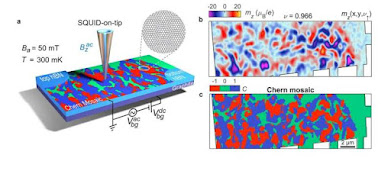The observation of Chern mosaic and Berry-curvature magnetism in magic angle graphene
Researchers at the Weizmann Institute of Science, the Barcelona Institute of Science and Technology and the National Institute for Material Science in Tsukuba (Japan) have recently probed a Chern mosaic topology and Berry-curvature magnetism in magic-angle graphene. Their paper, published in Nature Physics, offers new insight about topological disorder that can occur in condensed matter physical systems.
For more such news & interesting articles or how can it affect in your life subscribe to our newsletter.
"Magic angle twisted bilayer graphene (MATBG) has drawn a huge amount of interest over the past few years due to its experimentally accessible flat bands, creating a playground of highly correlated physics," Matan Bocarsly, one of the researchers who carried out the study, told Phys.org, "One such correlated phase observed in transport measurements is the quantum anomalous Hall effect, where topological edge currents are present even in the absence of an applied magnetic field."
The quantum anomalous Hall effect is a charge transport-related phenomenon, in which a material's Hall resistance is quantized to the so-called von Klitzing constant. It resembles the so-called integer quantum Hall effect, which Bocarsly and his colleagued had studied extensively in their previous works, particularly in graphene and MATBG.
Building on their past findings, the researchers set out to further investigate the quantum anomalous Hall effect using the measurement tools that they found to be most effective. To do this, they employed a scanning superconducting quantum interference device (SQUID), which was fabricated on the apex of a sharp pipette. This device is an extremely sensitive local magnetometer (i.e., sensor that measures magnetic fields), which can collect images in the 100nm scale.
"By varying the carrier density of our sample, we measured the response of the local magnetic field," Bocarsly explained. "At low applied fields this magnetic response is exactly correlated with the internal orbital magnetization of the Bloch wave functions, which is induced by the Berry curvature. So, in essence we have a local probe that measures the local Berry curvature."
Directly measuring the orbital magnetism induced by local Berry curvature in MATBG is a highly challenging task, which had never been attained before. This is because the signal is extremely weak, thus it eludes most existing magnetic measurement tools.
Bocarsly and his colleagues were the first to directly measure this elusive signal. During their experiments, they also observed a Chern mosaic topology in their sample, thus identifying a new topological disorder in MATBG.
"The Chern number, or the topology of an electronic system, is generally thought to be a global topological invariant," Bocarsly said. "We observed that on a device scale (order of microns), the C number is not invariant, but alternates between +1 and -1. This introduces a new type of disorder, topological disorder, into condensed matter systems that needs to be accounted for in device fabrication and theoretical analysis."
The recent study by this team of researchers greatly contributes to the understanding of MATBG, both in terms of its magnetism and topology. In the future, it could inform the development of more precise theoretical models of this material, while also potentially facilitating its implementation in various quantum computing devices.
"Our low field local orbital magnetization probe can also be used to investigate other fundamental properties such as local time reversal symmetry breaking," Bocarsly added. "There are still many open questions about integer filling states of MATBG and the symmetries that they obey, which could be an interesting direction for future exploration."
For more such news & interesting articles or how can it affect in your life subscribe to our newsletter.


Comments
Post a Comment